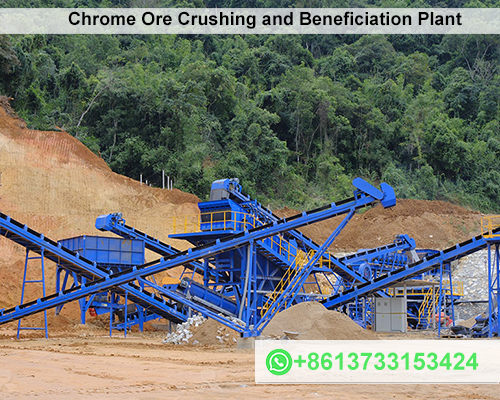Chrome Ore Crushing and Beneficiation Plant in South Africa
South Africa is home to the world’s largest reserves of chromite ore, which is the primary source of chromium. Chromium is a critical element in the production of stainless steel and other alloys, making the efficient processing of chrome ore an essential part of the country’s mining industry. This article explores the process of chrome ore crushing and beneficiation in South Africa, highlighting the importance of these operations to the national economy and global supply chain.

Introduction to Chrome Ore and Its Importance
Chromite ore is the key raw material used in the production of ferrochrome, an alloy that contains chromium and is primarily used in the manufacture of stainless steel. South Africa holds approximately 70% of the world’s known chrome reserves, making it a central player in the global chromium market. Chrome ore is typically extracted through open-pit mining, and the process involves both primary and secondary crushing to prepare the ore for further beneficiation.
The Chrome Ore Crushing Process
The first stage of chrome ore processing involves the crushing of ore to break it into smaller pieces suitable for further beneficiation. The ore is first extracted from open-pit mines, and then it undergoes primary crushing, which reduces it to a manageable size for the secondary crushing stages. The chrome ore is then fed into crusher that reduce the ore further into smaller particles, typically in the range of 50 to 100 mm.
Primary Crushing
Primary crushing is performed by large jaw crusher or gyratory crusher. These machines are designed to handle the tough, hard nature of chrome ore and are capable of reducing large chunks of ore to more manageable sizes for further processing. In some cases, a combination of primary crusher may be used depending on the geological characteristics of the ore body.
Secondary Crushing
Once the ore is reduced in size, secondary crushing is carried out to further reduce the particle size and prepare the material for subsequent beneficiation stages. Cone crusher and impact crusher is commonly used for secondary crushing. These crusher ensure that the material is small enough to pass through the next stages of sorting and processing.
Chrome Ore Beneficiation
After the crushing stages, chrome ore undergoes beneficiation, which is the process of upgrading the ore by removing impurities and improving the chromium content. South Africa’s beneficiation plants typically focus on two main processes:gravity separation and flotation.
Gravity Separation
Gravity separation is the most widely used method for beneficiation of chromite ore. This technique exploits the difference in density between the chrome ore and the gangue minerals. Ore is fed into a jig or a spiral concentrator, where heavier chromite particles are separated from lighter impurities. This method is efficient and cost-effective for the initial concentration of ore.
- Spiral Concentrators:These are used to separate finer chromite particles from waste material. The spirals create a centrifugal force that allows the denser chromite to sink and the lighter gangue to move upwards.
- Jigging:This method uses pulsing water to separate the denser chromite ore from the lighter waste. The separation occurs based on the density differences of the materials.
Flotation
Flotation is often used in combination with gravity separation to remove finer gangue particles. In this process, chemical reagents are added to the slurry to enhance the separation between the chromite and other minerals. Air bubbles are introduced to the slurry, and the valuable chromite particles attach to the bubbles, floating to the surface for removal.
Environmental Considerations and Sustainable Practices
Chrome ore beneficiation plants in South Africa are increasingly adopting environmentally friendly practices to minimize their impact on the surrounding ecosystems. The mining and beneficiation processes generate a significant amount of waste, including tailings, dust, and water runoff. To address these environmental concerns, several measures are being taken:
- Tailings Management:Tailings, which are the residual materials left after the beneficiation process, are being better managed. Advances in tailings storage facilities (TSFs) aim to reduce the environmental impact by minimizing the risk of contamination to groundwater.
- Water Recycling:Water is a critical resource in chrome ore beneficiation. As water consumption increases, beneficiation plants are implementing water recycling systems to reduce their reliance on fresh water sources.
- Dust Suppression:Dust is a major byproduct of the crushing and beneficiation processes. To mitigate this, modern dust suppression technologies are being integrated into processing plants to reduce emissions and improve air quality.
The Role of South Africa in Global Chrome Supply
South Africa’s chrome ore industry plays a pivotal role in the global market, providing a significant portion of the raw material for ferrochrome production. Ferrochrome is essential for the production of stainless steel, which is used in everything from construction materials to automotive parts.
The country’s chrome ore beneficiation plants contribute significantly to the local economy by creating jobs, driving exports, and supporting the downstream ferrochrome industry. In recent years, South Africa has been focusing on improving the efficiency of its beneficiation processes, which has helped to maintain its competitive edge in the global market.
Conclusion
Chrome ore crushing and beneficiation is a vital component of South Africa’s mining sector and plays a central role in the global chromium supply chain. The process of extracting and upgrading chrome ore through crushing and beneficiation helps to produce high-quality ferrochrome for the stainless steel industry. As the demand for stainless steel continues to grow, South Africa’s chrome ore beneficiation plants will remain essential to meeting this demand. Additionally, the adoption of sustainable and environmentally conscious practices will ensure that the industry continues to thrive while minimizing its impact on the environment.
By advancing technologies and improving the efficiency of processing operations, South Africa can further strengthen its position as a global leader in the chrome ore market.









